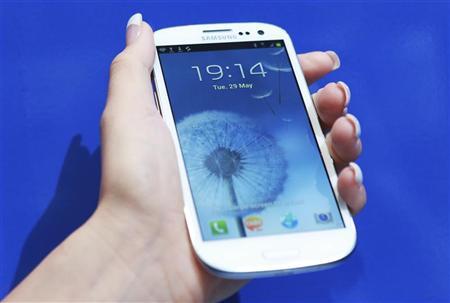(Reuters) – Samsung Electronics’ struggle to keep pace with rampant demand for its new Galaxy S III smartphone may have cost the South Korean firm some 2 million units of sales in just a month.

For a company that has never stirred the sort of consumer frenzy that accompanies each new Apple Inc gadget, overwhelming demand is a nice problem to have. But some of the shortage stemmed from a manufacturing glitch that affected some European sales, while major carriers in the United States have had to delay delivery of some pre-ordered phones.
The Galaxy S III has received the most positive reviews among any of the Samsung smartphones, and the technology giant says the phone is on track to become its fastest selling smartphone, with sales likely to top 10 million in the first two months since its launch.
The latest Galaxy’s launch has been well timed as the next iPhone is not expected until later this year, and offerings from others such as Google’s Motorola and Nokia have not created much of a market stir.
“Samsung might have been caught off guard by the demand, not because they did not believe in their own products, but because they might have over-estimated the competition,” said Gartner analyst Carolina Milanesi. “In other words, aside from the iPhone and HTC’s oneX there’s not much out there at the moment, which would have certainly helped Samsung.”
Analysts reckon the Galaxy shortage will be a temporary hiccup, affecting some 2 million units of shipments in the April-June quarter. Samsung expects another record quarter of earnings from its handset business in the current period, helped by solid sales of its predecessor S II and phone-cum-tablet Galaxy Note.
Barclays lowered its forecast for Samsung’s second-quarter Galaxy S III shipments to 6.5 million from 8 million, but raised its third-quarter shipment forecast by 1 million to 15 million.
Samsung said component shortages have been resolved and it is running at full tilt to meet demand. “It is simply that demand far exceeded our expectation. But that doesn’t mean we had set a very conservative demand forecast,” Samsung said in an emailed statement to Reuters.
APPLE CHALLENGER
Samsung kicked off global sales of the Galaxy S III on May 29, but immediately signaled a delay of 2-3 three weeks for delivering the pebble-blue version of the model.
Less than a fortnight before launch, Samsung’s then CEO Choi Gee-sung, now head of parent Samsung Group’s corporate strategy office, ordered that half a million of the blue cases be thrown away as the design, with thin, silver stripes, was unsatisfactory, according to daily newspaper Chosun Ilbo.
After numerous design tweaks, Choi approved the final version on a Sunday less than 10 days before launch, the report said – as he was boarding a plane to fly to a court-ordered meeting in the United States with Apple CEO Tim Cook as part of a long-running patent dispute between the two smartphone powerhouses.
Samsung said on Tuesday that delays caused by the blue case issue were a temporary blip and had been resolved, adding that a supply shortage in the United States was rapidly getting back to normal.
In the United States, where sales were launched last week, major carriers including Sprint Nextel Corp and AT&T struggled to deliver pre-ordered smartphones. Sprint said on its website that both the 16 gigabyte and 32 GB models were out of stock, and an AT&T spokesperson said future orders would arrive within 10 business days based on available supplies.
Samsung launched its first Galaxy two years ago in a bid to counter Apple’s iPhone success. At the time, Samsung’s global smartphone market share was below 10 percent. It has since overtaken Apple, and the company said in late April that the new Galaxy would “substantially contribute” to second-quarter results.
Samsung sold 44.5 million smartphones in January-March, and current quarter sales are expected to top 50 million.
“It’s increasingly apparent the Galaxy S III is being considered a true peer to the iPhone, rather than simply the least-bad alternative,” said CLSA analyst Matt Evans.
“The change in status is most evident in the uniformity of the device among the five U.S. carriers. Unlike the Galaxy S II, there’s little customization. Samsung has obviously developed huge leverage in negotiations with carriers and created a ‘must have’ handset.”
(Additional reporting by Nicola Leske in New York; Editing by Ian Geoghegan)





